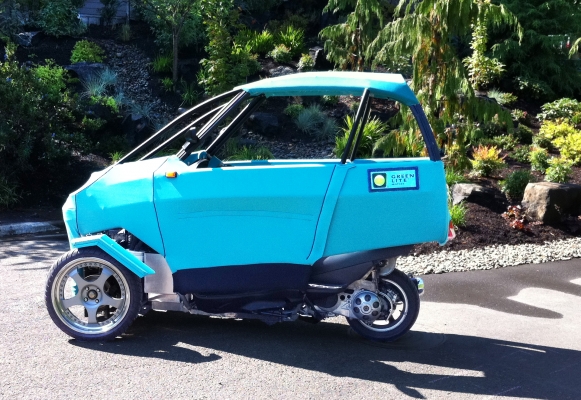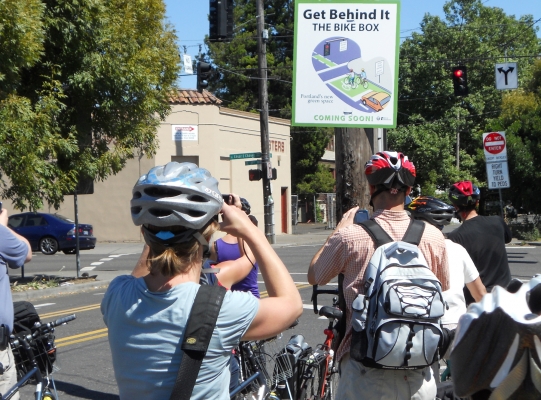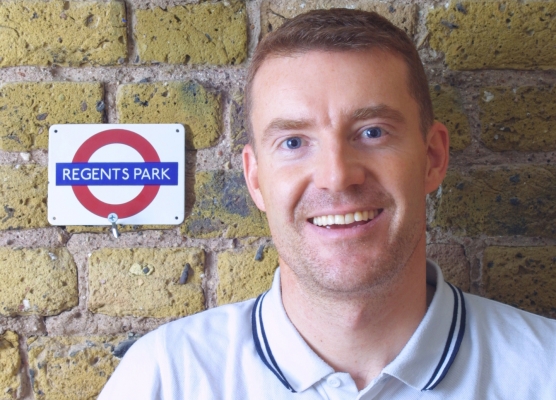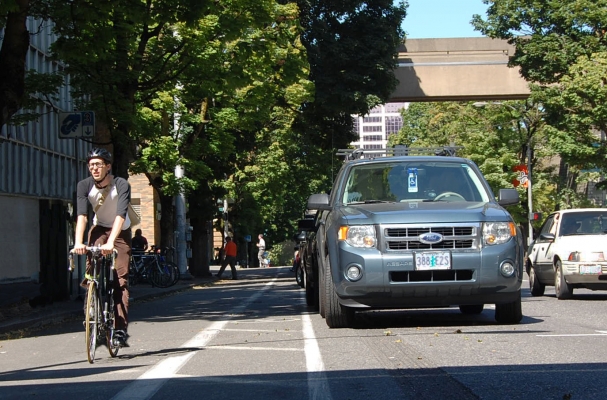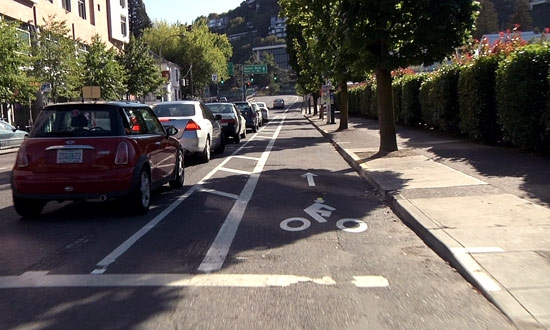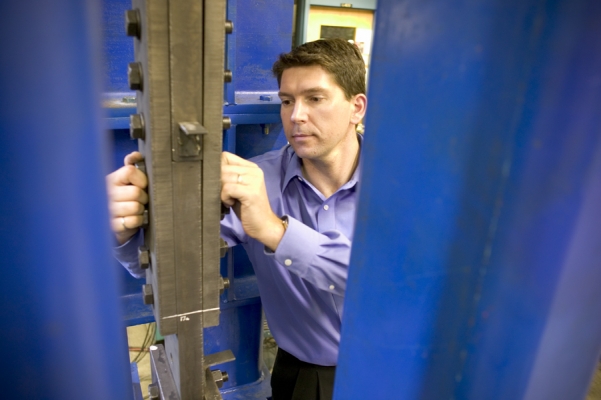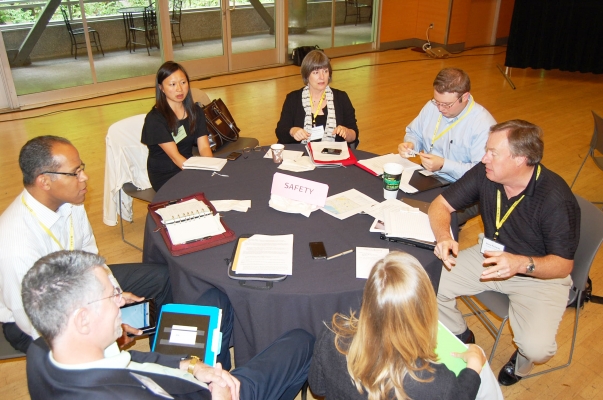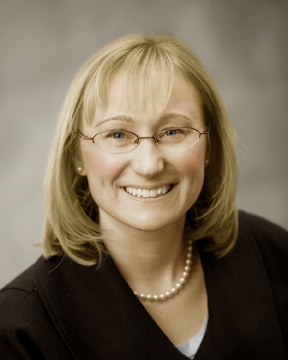OTREC has teamed up with Portland-based Green Lite Motors to bring a 100 mile-per-gallon vehicle closer to market. OTREC researchers at the Oregon Institute of Technology will evaluate and improve the performance of the two-seat vehicle.
The project grows out of a commercialization grant from the Oregon Built Environment & Sustainable Technologies Center, or Oregon BEST. Oregon Tech researchers built a prototype model for Green Lite Motors under that grant.
"This is going to take it from a completed prototype to a refined drive system,” said Tim Miller, president and CEO of Green Lite Motors. “They’ll test the performance and efficiency of the hybrid drive system and we’ll be able to refine the software and other things that control the system and optimize its performance.”
The Oregon Tech team built a three-wheeled prototype vehicle based on the Suzuki Burgman 650 scooter platform. “It combines the best of several things,” Miller said. “You get the full enclosure and safety you have in a car but with the nimbleness and ease of parking of a motorcycle.”
Although researchers can adapt some of the auto industry’s testing methods, others don’t apply very well for such an unusual vehicle, said Oregon Tech Associate Professor James Long, the project’s principal investigator. “There aren’t many vehicles out there of this type, so we’ll be...
Read moreThe Initiative for Bicycle & Pedestrian Innovation at Portland State University hosted a weeklong boot camp on bicycle and pedestrian design geared toward transportation planners, engineers and other public officials.
“There’s a dearth of knowledge among most practitioners,” said IBPI Director Lynn Weigand. “Most engineering and planning curricula don’t include any elements of bicycle and pedestrian planning and design.
“There’s an increased demand for alternatives to make communities safer for biking and walking.”
The intensive course, Aug. 15 to 19, featured classroom sessions, discussions, daily field tours of Portland facilities and project applications. Public- and private-sector experts served as program instructors.
For attendees, the program offered the chance to learn how various active transportation concepts fit together in one community. Tyler Palmer, a division manager with the Moscow, Idaho, public works department, came looking for guidance on his city’s multimodal transportation master plan.
“This is going to be really helpful for us in steering that process,” Palmer said. “It will help give us the tools we need to analyze our system and see what works best.”
Jumping into a master plan without...
Read moreDesigning efficient transit systems is only one piece of the puzzle. Getting people to use them is another.
In his bestselling “Transit Maps of the World” and followup work “Paris Metro Style: In Map and Station Design,” Mark Ovenden detailed the beauty of maps people use to navigate transit systems and of the stations themselves.
“When you walk into the Paris Metro system, with its art nouveau stations, it does affect you, whether you notice it or not,” Ovenden said. “It feels nice to be in. It encourages people to use the train.”
Ovenden will offer his take on transportation systems as the keynote speaker at the Oregon Transportation Summit, Friday, Sept. 9 at Portland State University.
Ovenden vaulted to fame with “Transit Maps of the World” after a career in radio and television. But he always had an interest in collecting maps and riding transit systems. “On a school trip to Paris at 9 or 10, I just wanted to ride the Metro all day,” he said. “The teacher said, ‘no, come with us to the Eiffel Tower, you idiot.’”
Even out of context, the maps Ovenden compiled serve as an art work. But much of their beauty lies in their function: getting people around smoothly. Some of the best...
Read moreMoving cyclists just a few feet from automobiles can make a big improvement in air quality, an OTREC research project found. That’s the distance between a traditional bike lane and a separated cycle track.
Researcher Linda George, the chair of Portland State University’s Environmental Science and Management Department, looked at Portland’s Broadway cycle track as part of a study on urban air quality. Download the final report. Specifically, George’s team examined the microscopic particles, called ultrafine particles (UFP), given off by automobile engines.
Those tiny particles can get deep into lungs and other tissues and contribute to a host of ailments. Cyclists are doubly at risk: they bike through some of the highest concentrations of UFP while their exertion causes them to breathe more heavily, introducing more of the particles into their systems.
George and her team, which included Portland State associate professors Miguel Figliozzi and Chris Monsere, looked at whether distance and barriers affect the amount of UFP that cyclists encounter. Portland’s Broadway cycle track offered a perfect study setting. In 2009, the Portland Bureau of Transportation created a dedicated cycle path by moving parking away from the curb, using parked cars to separate bicycle and...
Read moreOn May 25, OTREC Director Jennifer Dill traveled to Vancouver, B.C. to talk about the impact of new bike lane facilities in downtown Portland. The conference, Changing Lanes, was about improving bike-car relationships on Canada’s roads. The conference attracted leading international and domestic experts to discuss issues and research on bike/car safety, infrastructure and the business opportunities and costs of increasing bike use in cities.
Dill participated in the panel discussion “Building A Better Connection: How Can We Build Infrastructure That Supports A Smoother Relationship For Drivers and Cyclists” (Watch the discussion here). She was joined by Erick Villagomez, professor at the University of British Columbia School of Architecture; Luci Moraes, transportation planner for the city of Surrey, B.C.; Darryl Young, urban planner and steering committee member for the Toronto Coalition for Active Transportation; and Councilor Geoff Meggs of the city of Vancouver.
Dill presented research performed by OTREC on the reactions of cyclists, motorists and pedestrians to new bike facilities. In the summer of 2009, the city of Portland installed a cycle track on SW Broadway near PSU’s campus which served as the primary study area. Researchers surveyed users in the area to gauge their reactions.
“Overall,...
Read moreA major seismic event is predicted to hit the Oregon Coast any year now, which has transportation planning experts asking, “Is Oregon prepared?”
OTREC seismic expert and Portland State University Associate Professor of Civil and Environmental Engineering Peter Dusicka recently spoke at a May 13 symposium titled, Next Big Earthquake In Oregon: Are We Ready? Along with five other PSU professors, the Maseeh College-sponsored symposium addressed the state’s preparedness in terms of emergency response and infrastructure. Dusicka’s talk focused on the ability of Oregon’s bridges to perform in a major earthquake.
“We depend on our network of bridges for anything from immediate emergency response to transportation of goods and services,” Dusicka said. “There is no doubt that there is an inventory (of bridges) within Oregon of a certain vintage where we know there will be issues.”
The ability of a bridge to withstand a seismic event can depend on the type of bridge, when it was constructed and how it’s supported in terms of a foundation, Dusicka said. OTREC recently worked with ODOT to examine several hundred bridges in Oregon for seismic deficiency. The most telling trait, Dusicka said, is age.
“Over time, we’ve learned the ways we’ve designed and built bridges are not the best for resisting earthquakes,” Dusicka said. “The challenge with remediation today is, do we have the knowledge to do this effectively, and if we do, do we have the funds to execute...
Read moreFixing a community’s pedestrian and bicycle infrastructure issues could be as simple as turning on one’s smart phone in the future. At least that’s the hope of OTREC researchers Marc Schlossberg, Ken Kato, Dana Maher, Cody Evers, and Christo Brehm of the University of Oregon.
In the report, Transportation Planning Through Mobile Mapping (Read The Full Report Here), researchers developed and tested the Fix This Tool, a smart phone application that allows community members to assess problems within their transportation environment. The goal was to create a tool that could be affordably distributed to communities across the country so pedestrians and cyclists can actively participate in improving their means of transportation.
As the desire for reduced carbon emissions, reduced congestion, and reduced public spending on transportation infrastructure grows, many state and local governments are looking to encourage walking and bicycling in their communities as an alternative to cars. However, current data on pedestrian and bike networks are limited and there is little understanding on what constitutes appropriate bike and pedestrian infrastructure. To remedy this, local governments must engage residents to find out challenges current users face and what infrastructure is needed to increase biking and walking by residents.
Previous OTREC research developed a tool built on a GIS platform (...
Read moreEven with uncertainty clouding the future of university transportation research, more than 150 people from around the country showed their dedication to providing the most useful transportation research at the Council of University Transportation Centers’ 2011 summer meeting. OTREC hosted the conference June 13-15 at Portland State University.
University transportation researchers and staff, along with federal and state transportation officials, convened for three days of work sessions, meetings and exploring. OTREC-organized tours gave a Portland flavor to the proceedings, letting visitors explore the city by every available transportation mode. The 4T trail took participants on a light-rail train, a trail, an aerial tram and a streetcar (or trolley). The bike tour showed off the bicycle infrastructure that is making Portland nationally known. An architecture walking tour highlighted downtown Portland’s buildings and parks. And the food-and-beer tour explored the city’s burgeoning food-cart scene and copious microbreweries.
For many people, the conference...
Read moreLeadership from elected officials and access to federal and state funding are crucial components for successful transportation and land use planning in urban areas, according to a study recently completed by Portland State University’s National Policy Consensus Center.
The study, “Regional Transportation and Land Use Decision Making In Metropolitan Regions: Findings From Four Case Studies” (Read The Full Report Here) looked at efforts by regional agencies in four urban areas to coordinate land use and transportation via governance, coordination, growth centers and transportation improvement programs. The study is part of an OTREC project led by Rich Margerum of the University of Oregon’s Department of Planning, Public Policy and Management.
Margerum, along with Robert Parker of UO and Susan Brody and Gail McEwen of the National Policy Consensus Center, looked at the Puget Sound Regional Council in Washington, Metro in Oregon, the Denver Regional Council of Governments in Colorado and the San Diego Association of Governments in California for the project. The team examined literature and reports, conducted 40 interviews and also conducted an online survey of over 450 individuals within the four regions. In addition, a symposium was held in September 2010 with representatives from the four regions, the US Department of Transportation, Environmental Protection Agency and other...
Read moreThe U.S. House of Representatives Subcommittee on Technology and Innovation heard testimony earlier this month crafted by OTREC regarding continued funding for transportation research and University Transportation Centers.
On June 14, Lynn Peterson, Sustainable Communities and Transportation Policy Advisor to Governor John Kitzhaber delivered testimony (Read The Full Statement Here) prepared by OTREC, the Oregon Department of Transportation and others on how transportation research can maximize the return on investment of taxpayer dollars when it comes to transportation projects. The testimony was given to ensure continued federal support and funding for transportation research in the state of Oregon. In particular, Peterson requested continued support of University Transportation Centers (UTCs), like OTREC.
“The next transportation authorization needs to continue to provide a means of addressing the needs of applied and advanced research which is regional and national in scope,” Peterson said in the testimony. “In Oregon, we have developed a very successful model of collaboration between our research universities and between (OTREC), (ODOT) and local governments. This collaboration allows us to stretch our resources further and leverage our expertise and funding across our institutions, and ensures that research is able to be put into...
Read more
